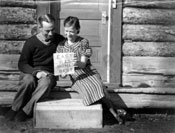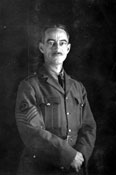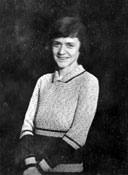|
The Right Place at the Right Time

Portrait of Claude and Mary, Mayo, 1934.
Yukon Archives: 1/112 #706, PHO 607
We are very fortunate that Claude and Mary Tidd lived in the Yukon Territory when they did. In the lean years between the Klondike Gold Rush of 1897-‘98 and the construction of the Alaska Highway
in the Second World War, the population of the territory fell drastically and there were few on hand to document the changes in Yukon culture. Claude, a member of the Royal Canadian Mounted Police, came armed with his camera and an insatiable passion for photography.
Mary was equally productive; an indefatigable correspondent, she sent many detailed accounts of life in the North back to her family in the United States.

Portrait of Claude in his uniform, Mayo, 1933.
Yukon Archives: #7360
Both Tidds preferred postings in remote and small communities like Forty Mile, Ross River and Old Crow. There they lived close to the land, chopping wood, hauling water, traveling by dog team and snowshoes or by canoe. As they learned the skills that the Yukon’s First Nations people had used to live in the challenging wilderness for millennia, they shared that education with the outside world and documented the details for posterity.
Claude and Mary were not simply dispassionate observers but full participants in Yukon society and in the economy.
The images and words the Tidds created encompassed far more than their own immediate lives. They documented the complex interrelationships of cultures, professions, personalities and philosophies to which they contributed and by which they were moulded. Their lives were thoroughly interconnected with their neighbours: First Nation families, blue-collar laborers, trappers, traders, missionaries and people from every other level of society up to and including the Yukon’s Member of Parliament. The Tidds were also on hand to record significant changes. For instance, they were witnesses and participants as airplanes and radio drastically reduced the isolation of the far northern communities.

Portrait of Mary, Mayo, 1933.
Yukon Archives: #7361
The Tidds had been raised in middle-class security but chose a demanding life at, what was, in Tennyson’s words, “the quiet limit of the world.” They were kindred souls who preferred dog sleds over motor vehicles, trails over city streets, and hiking in the bush over shopping in a big city. The couple had their difficulties, but these were caused more by social pressures, financial stress and health problems, than by anything the northern wilderness could throw at them. They were forever defined by the Yukon – the struggles they faced, the friendships they formed, and the lifestyle they embraced. Their romance is the core of an enlightening and moving story.
|

























